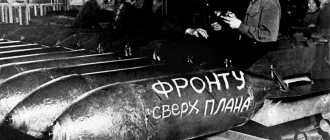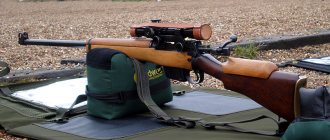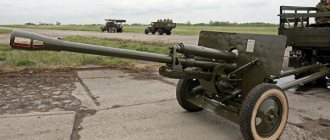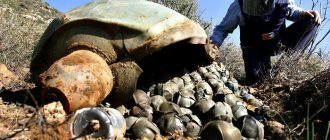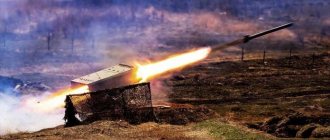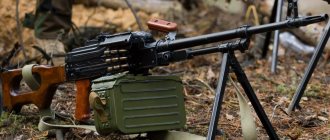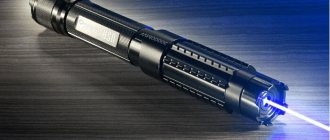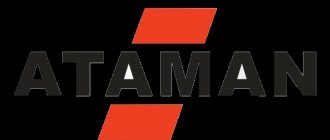Fat man
A 21 kt bomb dropped on Nagasaki in 1945. It was based on implosive detonation technology. The design consisted of a 6-kilogram plutonium core surrounded by a heavy shell made of uranium-238, which reflects neurons. On the outside there was another shell, aluminum, the purpose of which was to distribute compression evenly. Finally, a 2-centimeter ball of beryllium was mounted inside the core, serving as the initial source of neutrons.
After the end of the war, the US authorities, fully appreciating the power of this type of bomb (dubbed Mark-III), ordered 200 more for their weapons. In total, 120 devices were produced in the 4 post-war years, then they were considered obsolete and replaced with a more modern type - Mark-IV. Subsequently, neutron initiation was practically never used anywhere else, being considered insufficiently effective.
Delivery vehicles and bombing methods
Main means of delivering bombs:
- Manual delivery: Throwing (grenades, small land mines, etc.), sapper placement of charges into the ground or structures (mines, land mines).
- Automobile delivery: transportation of a charge in bulk or a bomb using vehicles without unloading or with partial unloading (military special operations and acts of sabotage by the enemy or terrorists).
- Aircraft bombing: targeted (laser or radio-guided), or “carpet drop” of a single charge or group of charges on a target, dropping charges by parachute, delivery of charges by unmanned robotic aircraft, high-altitude mining (suspension on balloons).
- Torpedoing: releasing a torpedo equipped with a warhead at a target (surface).
- Depth bombing: dropping deep anti-submarine bombs to a certain depth (direct bombing or mining of depths), as well as releasing underwater anti-submarine torpedoes or mining from submarines and leaving the mining zone.
- Missile delivery: Bombardment of charges of increased caliber, or nuclear charges of remote targets (including radio-guided or laser high-precision guidance).
- Orbital bombing: bombardment of ground targets with charges of increased caliber and power, and nuclear charges.
Etymology of the concept
The Russian word “bomb” comes from the Greek. βόμβος (bombos), onomatopoeia, onomatopoeic word, which in Greek had approximately the same meaning as the word “babakh” in Russian. In the European group of languages, the term has the same root “bomb” (German bombe
, English
bomb
, fr.
bombe
, Spanish
bomba
), the source of which, in turn, is Lat.
bombus
, Latin analogue of Greek onomatopoeia.
According to one hypothesis, the term was originally associated with battering guns, which first made a terrible roar, and only then caused destruction. In the future, with the improvement of warfare technologies, the logical chain of war-roar-destruction
became associated with other types of weapons. The term experienced a rebirth at the end of the 14th and beginning of the 15th centuries, when gunpowder entered the arena of war. At that time, the technical effect of its use was negligible (especially in comparison with the mechanical types of throwing weapons that had reached perfection), but the roar it produced was an extraordinary phenomenon and often had an effect on the enemy comparable to a shower of arrows.
BETAB-500 430 kg
Concrete-piercing aircraft bombs (BETAB) are designed to destroy objects that have strong concrete or reinforced concrete protection (fortifications, runways, etc.). Caliber 250-500 kg. It is a high-explosive aerial bomb with thicker walls and a more durable warhead (according to the American classification - a semi-armor-piercing aerial bomb).
For use from assault altitudes and ensuring the safety of the aircraft, it is equipped with a braking device (usually a parachute type) and an accelerating rocket engine, which is turned on after the falling speed of the aircraft bomb has decreased to a certain value as a result of the action of the braking device.
The development of Soviet jet armor-piercing and concrete-piercing bombs began in 1940 at GSKB-47 and NII-3. The armor-piercing bomb BRAB-200 DS and the concrete-piercing bomb BETAB-150 DS entered service during the Great Patriotic War.
In the 1940s they were called aerial bombs with additional speeds, hence the letters DS in the names of the bombs. The warheads of both bombs were 203 mm artillery shells (armor-piercing and concrete-piercing, respectively).
The design of the BETAB-150 DS concrete-piercing bomb is close to that of the BRAB-200 DS. Bomb length 2097 mm. The total weight of the bomb is 165 kg. The weight of the warhead is 101.6 kg. The warhead contains 14.5 kg of explosive and a RD fuse.
Baby
A uranium bomb with a yield of approximately 13-18 kt, manufactured as part of the Manhattan Project. It was the world's first atomic bomb used for attack purposes, dropped on the city of Hiroshima in 1945. The device measured 3 meters in length, 0.71 meters in thickness, and weighed 4,000 kg. The baby was a cannon bomb, this technology works flawlessly, unlike implosion, and is also quite simple to manufacture.
Inside was placed 64 kg of pure uranium mined in the USA, Canada and Congo, of which about 700 grams directly took part in the reaction. The explosion did not cause severe environmental pollution, because it occurred 600 meters above the surface of the earth, moreover, uranium, which did not take part in the reaction, is not the object of strong radiation.
Many countries in the world have already abandoned the very idea of producing and storing atomic weapons. Let's hope that this step will benefit the planet, and that other states will soon follow their example, because war is scary, but nuclear war is even worse.
Baker (23 kilotons)
This weapon, with a yield of 23 kilotons of TNT, is ranked seventh on our list of the most powerful nuclear explosions.
The bomb was created as part of the Crossroads project, which immediately followed Trinity. It was blown up in June 1946 in the area of Bikini Atoll, whose residents had previously been evacuated.
This was the first test of an atomic bomb at sea depth. The main goal was to determine the damage caused by a nuclear explosion to seagoing vessels. After an explosion carried out at a depth of 27 meters, a half-kilometer nuclear mushroom was formed. About 2 million tons of sea water rose into the atmosphere.
After the test, living on Bikini Atoll was prohibited due to radioactive contamination.
Fat Man (21 kilotons)
The “fat man” took ninth place in the ranking of the most powerful nuclear bombs in the world. This is how the name is translated from English. Fat Man USA used in Nagasaki. The power of the “fat man” exceeds the power of the “baby” by 3 kilotons.
Exploding in the sky over a defenseless Japanese city, the bomb killed 80,000 civilians. The effects of radiation sickness are still evident in descendants of nuclear bomb victims. This was the second and last nuclear bomb explosion in human history used for actual combat purposes.
Castle Yankee (13.5 megatons)
At that time, the United States dreamed of making a small bomb, but with great power. As part of a series of Castle tests, a prototype of such a device was created. It was called Castle Yankee. After the test, it turned out that the power of the explosion was more than 13 megatons. This made Castle Yankee the third most powerful nuclear bomb in the world.
Castle Yankee was the second most powerful bomb manufactured and tested by the United States.
A nuclear mushroom with a height of more than 40 km and a cap diameter of more than 16 km created a radiation cloud that reached the capital of Mexico within 4 days.
Rhea
This was the name of the most powerful bomb ever made in France. For comparison, the United States dropped explosive devices of 20 kt each on Hiroshima and Nagasaki, and an explosion with a power of 50 times more occurred on the coral island of Mururoa. A year before, the Unicorn, a bomb with a power of more than 900 kt, was exploded at the same place, and a few hours after that, the French Minister of Defense swam in the water - he wanted to prove that nuclear weapons were completely safe.
In total, France conducted more than two hundred tests in its overseas territories - Polynesia, Algeria. The last one took place in 1998.
ZAB-500 500 kg
The ZAB-500Sh incendiary bomb, 500 kg caliber, is designed to destroy military equipment (aircraft in open parking lots, cars, radar stations), open ammunition depots, fuel and lubricant depots, buildings with light ceilings, etc., as well as manpower at any time. time of year at ambient temperatures not lower than -25 0C and the presence of snow cover up to 20 cm.
ZAB-500Sh can be used from heights of 50 m and above. It is most effective when used from altitudes up to 500 m in the dry season at positive ambient temperatures.
The aircraft bomb can be used from level flight, dive and pitching of the aircraft. Setting the long-range fuse arming time to 1.5 s ensures the trouble-free operation of the incendiary aerial bomb when bombing from altitudes from 50 to 1000 m and the safety of the carrier aircraft from being damaged by fragments of a dropped aerial bomb when the aircraft's horizontal flight speed is at least 700 km/h.
